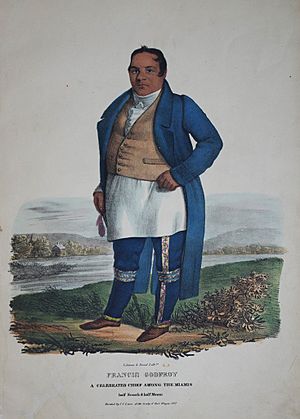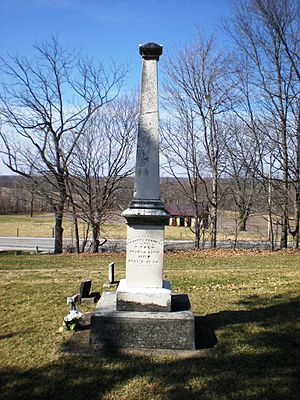Francis Godfroy facts for kids
Francis Godfroy (whose Miami name was Palaanswa) lived from 1788 to 1840. He was an important leader, or chief, of the Miami people. He worked with the United States government to create agreements, called treaties, for his tribe.
Contents
Early Life and Miami Roots
Francis Godfroy was born in 1788. His birthplace was a village that belonged to Chief Little Turtle. Today, this place is known as Fort Wayne, Indiana. His father, Jacques Godfroy, was a French trader. His mother was a Miami woman. His Miami name, Palaanswa, sounded like the French name François.
Before the War of 1812, the Miami people had few problems with settlers. However, after 1809, they did not want to give up more land in Indiana. This led to attacks by American soldiers on their villages. These villages were along the Mississinewa River, near what is now Peru, Indiana. Francis Godfroy was a leader in a Miami counterattack. This happened during the Battle of the Mississinewa in December 1812.
A Career in Trading
After the War of 1812, Godfroy became more involved in trade. He worked with the Miami's main chief, Jean Baptiste Richardville. In 1823, Godfroy built a large, two-story trading post. It was located where the Mississinewa River meets another river. This post, called Mount Pleasant, always had many goods for sale.
Until 1827, he lived at Mount Pleasant and also at his land reserve. This reserve was in what is now Blackford County, Indiana. Because he was part French and part Miami, and a trader, he understood the value of land and goods. He became very important in helping Richardville sell tribal land. This happened at treaty meetings in 1826, 1834, and 1838.
Between 1818 and 1838, Godfroy received a lot of land. He got 17 sections of land, which is about 10,880 acres. He also received over $17,000. This was payment for his work as a chief and for debts owed to his trading post. He also received a house and other gifts.
Protecting Miami Interests
Even though Godfroy was well-paid, he was not just a puppet for American interests. He and Richardville worked hard to slow down land sales. They also tried to stop the Miami people from being forced to move. They worked with traders like the Ewing brothers. Together, they got much larger payments for the land the Miami gave up. They also managed to delay the Miami's forced removal longer than most other tribes.
Godfroy, Richardville, and another Miami chief named Meshingomesia were successful. They got special permission for their families to stay in Indiana. These small groups of Miami families became the main part of the Indiana Miami tribe we know today.
A Respected War Chief
In 1830, Francis Godfroy was chosen as the war chief of the Miamis. At that time, this role was mostly an honor. He passed away in May 1840 at his Mount Pleasant trading post. He was buried nearby in what is now Peru, Indiana. The Godfroy cemetery is still a Miami burial ground today.
Francis Godfroy had two wives and many children. He was a large man, over 6 feet tall and weighing about 350 pounds. He often wore a mix of European and native clothes. This included a vest, a blue coat, a ruffled shirt, a breechcloth, leggings, and moccasins. Two artists, George Winter and James Otto Lewis, painted his picture.
Godfroy was very important for the Indiana Miamis to continue as a tribe. His land around Mount Pleasant became a safe place for Miamis. Many returned from Kansas after being forced to move in 1846. His youngest son, Gabriel (Wapanakekapwah, meaning "White Blossoms"), became a leader. He led the Indiana Miamis until he died in 1910.
Godfroy's many children and grandchildren married into all the Miami family groups. Because of this, more than a quarter of the current Indiana Miami tribe can trace their family back to him. His descendants have continued to be leaders in the tribe. Ira Sylvester Godfroy (Mihtohseenia, "Indian"), his great-grandson, was a chief from 1938 to 1961. He helped the tribe win awards in land claims.
Another great-grandson, Clarence Godfroy (Keepaahpwa, "Looking over the Top"), was a famous Miami storyteller. He was one of the last people who spoke the Miami language fluently. In 1977, in a court in South Bend, Indiana, another great-grandson, Oliver Godfroy, won a tax exemption. This was for 79 acres of land that was part of Francis Godfroy's original treaty land.
Death and Lasting Impact
Francis Godfroy died on May 1, 1840. He was described as a very tall and heavy man. He had two wives, and they are buried near Peru, Indiana. A photo of their graves was printed in a book about Miami County, Indiana, in 1914. The Francis Godfroy Cemetery was added to the National Register of Historic Places in 1984. This means it's a special historical site.
See also



